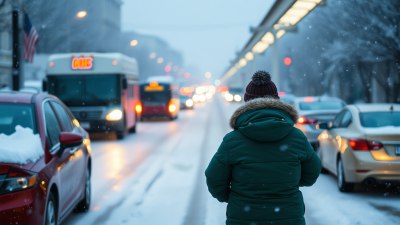How Winter Commutes Turn People Into Icy Versions of Themselves
Explore how harsh winter commutes affect behavior, safety, and mindset, turning people into icy versions of themselves during cold months.

Winter commutes can drastically alter people's behaviors and attitudes, often turning them into what one might call 'icy versions' of themselves. The chilling weather, treacherous road conditions, and shorter daylight hours all combine to create a unique travel experience that affects not only physical movement but also emotional and mental states.
During the colder months, people who once exhibited patience and kindness behind the wheel or on public transit may find themselves becoming more irritable, hurried, and guarded. This change is understandable given the increased stress of navigating snow-covered roads, dealing with delayed public transportation, or enduring the biting cold on foot or bike.
One of the primary factors behind this transformation is the heightened sense of vulnerability that winter conditions impose. Slippery sidewalks and icy patches on roads amplify the risk of accidents and injuries, which in turn heightens people's alertness and sometimes anxiety. These elevated feelings often manifest as defensive or withdrawn social behaviors, effectively making commuters less approachable and more “icy.”
Moreover, the physical discomfort of cold weather drives a powerful desire to reach one's destination as quickly as possible. This urgency can lead to reckless driving practices, such as accelerated speed despite icy roads, sudden braking, or tailgating. Such actions not only increase danger but also contribute to a cycle of frustration among drivers who may react similarly.
Beyond roadways, winter's effects extend into public transit environments. Delays become commonplace due to weather-related obstacles, and overcrowding on buses or trains tends to worsen as many shift from walking or cycling to public transportation to avoid the harshness of the cold. This crowding often diminishes personal space, which can heighten irritability and reduce social warmth among passengers.
In addition to external factors, the lack of sunlight during winter months plays a significant role in altering human behavior. Reduced exposure to natural light disrupts circadian rhythms and can contribute to Seasonal Affective Disorder (SAD), characterized by low energy, sadness, and irritability. Commuters suffering from these symptoms may appear less friendly or more withdrawn, reinforcing the 'icy' demeanor.
From a psychological perspective, the winter environment primes individuals for a survival mindset. The focus shifts toward self-preservation rather than social connection, as people concentrate on safely navigating slippery surfaces and cold exposure. This shift may explain why social niceties become rarer during winter commutes, contrasted with the warmth and community spirit often observed in milder seasons.
Interestingly, the physical layering necessary to combat cold weather also physically shields individuals from one another. Bulky coats, scarves, and hats cover faces and conceal expressions, hampering nonverbal communication cues that typically facilitate empathy and interaction. Masked faces and gloved hands create real barriers to social connection, potentially reinforcing the sense of isolation during transit.
The logistics of winter commuting further compound these effects. Vehicles require extra maintenance, such as defrosting windows, checking tire traction, and warming engines, which adds time and effort before even starting the journey. This pre-trip load adds mental fatigue and heightens the overall stress of commuting.
Additionally, the unpredictability of winter weather forces commuters into a state of hypervigilance. Sudden snowstorms, freezing rain, or unexpected ice patches demand constant attention and quick adaptation. This mental strain can overload cognitive resources, leaving less capacity for social engagement or patience with delays and other commuters.
Pedestrian commuters experience parallel challenges. Navigating icy sidewalks or poorly cleared paths requires slow, cautious movement, increasing travel time and physical exertion. The discomfort of wet, cold feet or exposed skin combined with the necessity for concentration reduces the propensity for casual interactions or outward friendliness.
Cold air exposure also physiologically restricts blood flow to extremities, sometimes causing numbness or discomfort that naturally encourages inward focus. This bodily experience parallels the psychological withdrawal noted in many winter commuters, creating a close link between physical sensation and mood.
Driving in winter conditions can feel like an endurance test rather than a routine activity. Each trip requires constant vigilance to maintain control on slick surfaces, adapt to diminished visibility caused by fog or heavy precipitation, and anticipate the actions of other cautious or panicked drivers. The cumulative fatigue from repeated stress during daily commutes can foster impatience and irritability once reaching the destination.
Moreover, winter road hazards often cause cascading delays. Traffic accidents on ice-covered streets or snow-blocked lanes create backups, leading to longer commutes and increasing frustration. These conditions frequently lead to a negative feedback loop where stress from delays spills over into behavior towards fellow travelers.
The social norms of winter commuting differ subtly but significantly from other seasons. For example, greeting neighbors or engaging in brief chats feels less natural when everyone is huddled into their own warm spaces, racing against cold discomfort rather than exchanging small talk. This environmental shift reduces opportunities for social bonding and contributes to a perception of coldness not only in temperature but in interpersonal connection.
Of course, not everyone succumbs to becoming icy versions of themselves during winter travel. Some people adapt by adopting proactive strategies that mitigate stress and foster warmth despite the season’s hardships. These individuals might leave earlier to accommodate slower travel, listen to calming music or podcasts en route, or seek to smile and exchange a word with fellow commuters, consciously counteracting the winter mood.
Communities and cities also play a role in shaping commuter experiences during winter. Well-maintained sidewalks, prompt snow removal, effective public transport management, and heated shelters can help reduce some of the physical and emotional burdens of winter commutes. Infrastructure improvements aimed at winter resilience contribute to safer, more pleasant journeys and can diminish the tendency toward defensive or irritable behavior.
Technological solutions also support winter commuters. Real-time weather and traffic updates help travelers make informed decisions, avoiding hazardous routes or changing schedules to avoid peak storm times. Cars equipped with advanced safety features like anti-lock brakes, traction control, and lane assist technologies help drivers maintain control and confidence despite icy conditions.
On a personal level, dressing appropriately with layers, thermal gloves, waterproof footwear, and insulated outerwear makes a significant difference in comfort and endurance during cold travel. Psychological preparation—such as expecting some delays and mentally framing the commute as a challenge rather than a nuisance—can help buffer frustration.
The metaphor of people becoming 'icy' during winter commutes extends beyond physical coldness to encompass these emotional and behavioral changes wrought by environmental stressors. The interplay between the harsh natural environment and human adaptation reveals much about how external conditions can shape internal states.
Understanding this dynamic offers valuable lessons. Recognizing why and how commuters become less patient or less connected during winter helps foster empathy among travelers and can motivate personal and community-level efforts to create smoother, warmer transit experiences in cold months.
Ultimately, winter commuting is a test of resilience—physical, psychological, and social. With greater awareness and intentional action, it is possible to thaw some of the iciness winter imposes and retain warmth, kindness, and patience despite challenging conditions.











